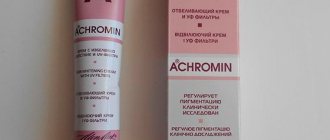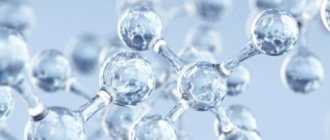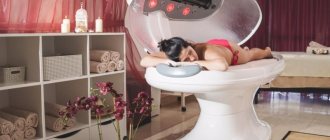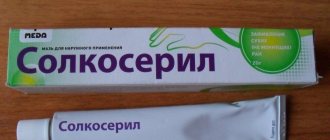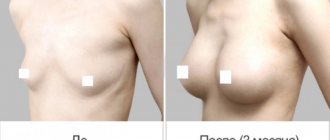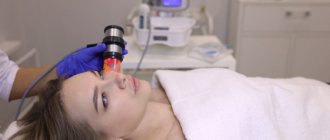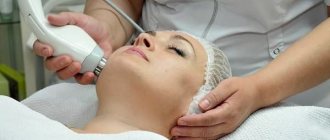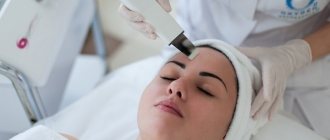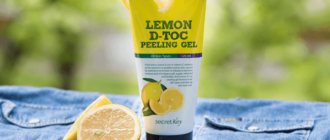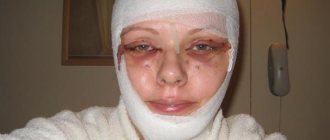Electrophoresis is a physiotherapeutic treatment method that is used for many diseases. This technique is based on the penetration of a drug through the skin and mucous membranes using an electric current. To carry it out, a special apparatus is used. The advantage of this method is that it can be used not only on an outpatient basis or in a hospital department, but also at home.
About the procedure
Electrolytic dissociation of a drug into individual ions is the basis for electrophoresis. Under the influence of an electric field, charged Lidase molecules are able to quickly move through the skin or mucous membrane. This accelerates the onset of the effect of the physiotherapy procedure and ensures rapid delivery of the drug to the site of the pathological process.
In addition, the phenomenon of galvanization itself has an effect on the cells of the body. The electric field stimulates metabolism, accelerates regeneration processes, has anti-inflammatory and analgesic effects, which can be used to carry out the technique for a large number of different diseases.
Electrophoresis with lidase in gynecology, or in any other field of medicine, rarely leads to side effects of treatment, and therefore can be performed on a large number of patients. Also, it is worth noting that the method is used not only in adults, but also in children.
Medicinal electrophoresis is an additional method of treatment for many diseases, however, it should not be used as a monotherapy. If necessary, medications can be used in combination.
Solutions used
A variety of solutions can be used for treatment using electrophoresis, but only the treating specialist can prescribe a particular remedy, for example, lidase. For example, in the case of heart diseases and vascular pathologies, calcium solutions are used. For atherosclerosis - novocaine. For chronic inflammatory processes and injuries - solutions of lidase or ronidase. This method is also effective for keloid scars and burns. In gynecology, electrophoresis is most often performed with another substance - the antibiotic tetracycline.
This type of treatment is very rarely used as an independent treatment. Most often it is prescribed in complex therapy of a particular disease. The duration of one such procedure can be from 10 to 30 minutes, but for young children and the elderly it should be minimal. For one full course, as a rule, 10 to 20 sessions are prescribed, which can be carried out every day or every other day.
Features of the physiotherapy procedure
Electrophoresis is the most commonly used physiotherapeutic procedure, both at home and in a hospital. This is due to the fact that the method has a number of important advantages compared to other types of treatment:
- the possibility of using a minimum concentration of drugs in solutions, since the drug has a high level of bioavailability during electrophoresis;
- the risk of complications is almost completely absent;
- a depot of medication is created in biological tissue under the influence of electric current, which ensures a long-term effect of treatment;
- patients do not experience pain during electrophoresis;
- The procedure is completely non-invasive and does not require intramuscular or intravenous injections.
The large number of benefits of physiotherapy determines its widespread use and positive reviews from patients and doctors of various specialties.
Indications and contraindications
Any type of procedure, for example, electrophoresis with lidase on the ears for otitis, has certain indications and contraindications for use. They are described in detail in the instructions for physiotherapy devices. Physiotherapists identify the following indications for using the method:
- surgical diseases associated with traumatic and non-traumatic injuries of internal organs, including fractures, hernias, etc.;
- disturbances in the functioning of the peripheral or central nervous system;
- diseases of the female reproductive system;
- degenerative changes in the osteoarticular system: spinal osteochondrosis, arthritis and arthrosis;
- adhesions in the abdominal cavity after surgical interventions;
- hypertrophic scars on the skin, etc.
In addition to the indications for medicinal electrophoresis, it is necessary to take into account contraindications that limit the use of physiotherapy:
- growth of malignant neoplasms;
- decompensated diseases of internal organs;
- acute period of inflammatory diseases;
- pregnancy period;
- individual intolerance to electric current;
- a history of bleeding associated with impaired blood clotting.
If any of the contraindications are present, the attending physician should refuse to use electrophoresis with Lidase in favor of other treatment methods.
Use in cosmetology
Electrophoresis with Lidase on scars is widely used in cosmetology, since this enzyme actively breaks down hyaluronic acid, which is the basis for the formation of scars on the skin. It is important to note that the procedure should be performed in the first days and weeks after the appearance of damage to the skin, for example, with postoperative sutures. This is due to the fact that it is in the “fresh” scar that a large amount of hyaluronic acid is observed. Subsequently, a proliferation of connective tissue is observed in the scar tissue, which is difficult to respond to the action of Lidase.
The technique for performing electrophoresis with Lidaza in cosmetology is as follows:
- The drug should be diluted to a certain concentration, which was selected by the attending physician. A fabric pad in which the electrode is placed is impregnated with this solution.
- The electrode is carefully fixed in the scar area using a gauze bandage or special bandages. The second electrode should be placed opposite the first to ensure local formation of the electric field.
- The doctor, or the patient himself if the procedure is performed at home, sets the required current strength and other parameters on the device, and then turns on the device.
- Upon completion of physical therapy, the electrodes are carefully removed from the skin.
Effective therapy requires a course of treatment of 10-15 sessions, each lasting about 10 minutes. If the procedure is performed on a child, then the time and number of sessions should be halved. If it is necessary to repeat sessions, a two-week break should be provided to restore tissue sensitivity to electric current.
It is necessary to strictly follow the instructions for use of the electrophoresis device, and also correctly use the Lidase solution to prevent the development of side effects.
Side effects
The drug is well tolerated by the biological system, but in some cases the effect of the pharmacological product may be determined by:
- the appearance of blisters, rashes, itching;
- abnormal redness of the skin;
- angioedema;
- anaphylactoid reactions;
- ventricular fibrillation (rare exceptions).
The drug should be used in accordance with the doses recommended by a specialist. In case of overdose, the following symptoms occur: chills, nausea, involuntary eruption of stomach contents, loss of balance, rapid heartbeat, decreased blood pressure, local edema.
Application in gynecology
This physiotherapeutic method is widely used by gynecologists to treat the following conditions:
- pathological processes of any causality in the vagina and uterine cavity;
- chronic cystitis;
- adhesions in the uterine cavity or pelvic area;
- decreased patency of the fallopian tubes;
- functional disorders in the organs of the female reproductive system, etc.
Unlike cosmetology, in gynecological practice one of the electrodes is usually inserted into the anatomical cavities (rectum or vagina), which provides a selective effect on the pathological focus. It is important to note that when administering agents through the mucous membrane, their dilution must be greater than usual. It is also recommended to use buffer solutions for electrophoresis with Lidase, which prevent the destruction of the active substance.
To conduct intravaginal or intrarectal electrophoresis, one of the electrodes should be replaced with a cavity electrode, which is a small metal tube. This electrode is placed in a special pad soaked in Lidase solution and buffer. After placing the electrodes, the attending physician turns on the device, setting the minimum current values. If a woman does not feel a tingling sensation, the current strength can be slightly increased.
The number of sessions in one course of treatment is 7-14. The duration of one session is from 5 to 15 minutes, depending on the severity of the pathological process. If necessary, the course of treatment can be repeated after a short period of time.
Other Applications
Electrophoresis with Lidase solutions is also used in other areas of medicine. The use of this method of treatment is especially effective in the presence of adhesions in anatomical areas, for example, in the cavity of the middle ear, etc. Lidaza allows you to quickly eliminate the adhesions and restore the patency of the auditory canal and fallopian tubes.
In addition to otorhinolaryngology and gynecology, physiotherapy is actively used in ophthalmology to influence diseases of the eyeball. It is important to note that in this case the doctor must properly dilute Lidaza, observing the proportion indicated in the instructions with the buffer.
The use of electrophoresis is justified for diseases of the urinary system and symptoms of its damage: frequent urination, pain in the bladder (lower abdomen), erectile dysfunction. In these cases, in addition to the cutaneous application of electrodes, endural administration is possible.
How to prepare ear drops (Lidaza)
Hello, Today I visited an ENT doctor due to noise in the ear and a single discharge of blood, and was diagnosed with a pinpoint perforation of the eardrum. I was prescribed Normax, vitamin B, and lidase. Question: how to prepare ear drops? Since in the instructions I did not find any use in ENT practice, but the doctor wrote lidase + water for injection 5k. 3-4 times a day. I have lidase powder 5 ml and water also 5 ml.
Thank you in advance for your response!
Related and recommended questions
2 answers
Site search
What should I do if I have a similar but different question?
If you did not find the information you need among the answers to this question, or your problem is slightly different from the one presented, try asking an additional question to the doctor on the same page, if it is on the topic of the main question. You can also ask a new question, and after a while our doctors will answer it. It's free. You can also search for the information you need in similar questions on this page or through the site search page. We will be very grateful if you recommend us to your friends on social networks.
Medical portal 03online.com
provides medical consultations via correspondence with doctors on the website. Here you get answers from real practitioners in your field. At the moment, on the site you can get a consultation in 45 areas: an allergist, venereologist, gastroenterologist, hematologist, genetics, gynecologist, homeopath, dermatologist, children's gynecologist, children's neurologist, children's surgeon, children's endocrinologist, nutritionist, immunologist, cardiologist, cardiologist, cosmetologist, cosmetologist, cosmetologist speech therapist, ENT specialist, mammologist, medical lawyer, narcologist, neurologist, neurosurgeon, nephrologist, oncologist, urologist, orthopedist-traumatologist, ophthalmologist, pediatrician, plastic surgeon, proctologist, psychiatrist, psychologist, pulmonologist, rheumatologist, sexologist-andrologist , dentist, urologist, pharmacist, herbalist, phlebologist, surgeon, endocrinologist.
Electrophoresis in childhood
Drug electrophoresis with Lidase can also be used in children. Many parents fear that exposure to electric current can lead to health problems and disruption of the child's development. Such fears are unfounded. The current values used are completely safe for children of any age, and therefore physiotherapy can be used to treat a large number of pediatric diseases - inflammatory diseases of the eyes, ears, etc.
The use of physiotherapy can improve the results of treatment of congenital anomalies of the structure of internal organs.
Prescription of medicinal electrophoresis in childhood should always be carried out only by a pediatrician. The doctor needs to carefully examine the child and identify his indications and contraindications for this type of physical treatment or its analogues.
Correct use of electrophoresis with Lidase allows you to effectively treat various diseases associated with damage to internal organs and skin. Before prescribing therapy, the attending physician must assess the patient’s health status and the presence of restrictions for carrying out the physical procedure. Lidase, due to the destruction of hyaluronic acid, allows you to reduce the severity of scars on the skin, eliminates adhesions, which is widely used in gynecology, ophthalmology, neurology and other areas of medicine. It is important to note that when carrying out the procedure at home, you must strictly follow the instructions for using the electrophoresis device.
Electrophoresis of the ear and other physical procedures for otitis media - Website about eye diseases and their treatment
Physiotherapy is a complementary treatment that is based on various procedures.
In case of ear inflammation, such measures help not only to speed up recovery, but also to speed up the effect of prescribed medications.
The effect of the prescribed treatment methods is expected to be complex, since physiotherapy, with the correct and timely effect on the patient’s body, is capable of:
- Shorten the treatment period;
- Increase the effectiveness of prescribed medications;
- Reduce the risk of developing allergies from drugs;
- Minimize the development of adverse reactions from taking pills;
- Remove inflammation;
- Reduce pain.
The main goal of physiotherapy is to increase the effect of treatment without negative effects on internal organs, without complications, without side effects.
The list of physiotherapeutic measures for otitis media includes:
- UHF;
- Electrophoresis;
- Ultraviolet radiation;
- Microwave therapy;
- Pneumomassage;
- Blowing and rinsing the ear;
- Sollux, etc.
Electrophoresis for otitis media, UHF and magnetic therapy are considered classic treatments for this disease. Often, otolaryngologists refer their patients to such procedures, but it all depends on the type of disease and the stage of exacerbation.
UHF for otitis is considered a universal treatment method, because ultra-high frequency heating of the ears is appropriate to use in the acute phase of the disease, as well as for the treatment of the chronic form.
Methodology
For otitis media, physical therapy is considered an essential element of treatment. Electrophoresis is the most common procedure prescribed to most patients for exudative otitis media, when pus begins to accumulate. It is impossible to delay the treatment of such a disease, as it can quickly develop into a chronic form.
Electrophoresis affects the diseased area using direct current and an injected pharmaceutical drug. This procedure allows the drug composition to more actively influence the source of inflammation. The current accelerates the process of penetration of the product through the ducts of the glands on the body.
The electrophoresis device has positive and negative electrodes. Often the negative (cathode) leads and wires are painted black, and the anode electrodes are painted red.
Special gaskets are placed between the electrode and the surface that will be treated. They are pre-impregnated with the medicinal substance. To treat otitis media, an electrode is placed either in the nose or in the ear. When turning on the device, the patient should not feel any discomfort, there may only be a slight tingling sensation.
The current density during the procedure is determined by the doctor. If there is a slight burning sensation, then you need to immediately reduce the density of the waves. This procedure for the treatment of otitis media is considered effective, since the current flows directly into the diseased area without penetrating the skin.
Electrophoresis with lidase is used for the accumulation of purulent masses in the ears, since lidase is an enzyme product that promotes the breakdown of hyaluronate. The substance helps to quickly relieve swelling, reduce the density of pus, and speed up its release from the ear cavity.
Warming techniques
Physiotherapy for adults with otitis media is based on a warming effect, which is achieved by various techniques. The main task is to relieve inflammation and quickly reduce ear pain. The most common warming techniques in this area are:
- Phototherapy or Sollux;
- Electrophoresis;
- UHF.
Phototherapy involves the use of a specialized incandescent lamp or UV lamp. The Sollux lamp, if used for general irradiation, is installed at a distance of 1 m from the patient. The warming up procedure can last from 15 minutes to an hour, it all depends on the diagnosis and form of the disease.
Electrophoresis also has a warming effect, but heating occurs due to direct current. Antibiotic drugs, lidase, etc. are often used to warm the ear. The choice of drug is made by the doctor. The duration of the procedure varies between 10-20 minutes.
The procedure allows you to reduce the dosage of the prescribed drug, which minimizes the risk of side effects.
Due to the absence of pain during the procedure, electrophoresis is often prescribed for physiotherapeutic treatment of otitis media in children.
UHF is a procedure based on exposure to a high-frequency electromagnetic field. During treatment with this technique, fluid may accumulate in the ear, which is undesirable during the treatment of acute otitis media. UHF is appropriate to use in the early stages of otitis development.
For complete recovery, 5-7 procedures of 5 minutes each may be sufficient. If the patient is diagnosed with purulent otitis media, the number of procedures is doubled. In this condition, it is especially important to monitor the activity of pus discharge.
If purulent masses flow freely, then the duration of UHF is increased to 1 minute per session.
Stimulating treatments
Stimulating techniques in the treatment of otitis media can speed up the process of removing purulent masses, normalize blood flow in the area of inflammation, reduce swelling, and increase muscle tone of nearby tissues. List of procedures that can be prescribed for inflammation of the hearing organs:
- Pneumomassage;
- Amplipulse therapy;
- Magnetotherapy;
- Diadynamic therapy.
Pneumomassage consists of active alternation of air flows, which are distinguished by high and low pressure. This pressure helps create a special device that works by constantly oscillating the eardrum. Frequent changes in pressure prevent a decrease in muscle tone. A similar effect can be noticed when pumping air with your palms.
Amplipulse therapy is based on the influence of sinusoidal currents. The amplitude of fluctuations directly depends on the form of the disease. The effect of the procedure is noticeable in cases where the patient experiences severe pain.
Sinusoidal currents during amplipulse therapy can accelerate blood flow, quickly eliminate congestion, and reduce swelling during inflammation.
By reducing swelling, pain disappears, and accumulated fluid or pus is easily drained.
Magnetotherapy involves the use of a low-frequency magnetic field. Such magnetic waves during treatment often do not exceed a frequency of 50 Hz. The duration of the procedure does not exceed 10 minutes. To combat acute otitis media, a minimum of 10 procedures will be required. Magnetic therapy helps to increase the tone of venules, relieve swelling, and increase the activity of the lymphatic drainage system.
Diadynamic therapy is also carried out using rhythmic currents. Currents can affect the cortical and subcortical centers of the head, which accelerates blood flow in the middle ear. This procedure also helps to increase the mobility of the auditory ossicles. The average duration of one diadynamic therapy session is 10 minutes.
Cleansing methods
During the treatment process, it is often necessary to cleanse the ear canal, so for such purposes, doctors prescribe cleansing physiotherapy procedures in the form of washing or blowing the ear.
Ear blowing involves clearing the Eustachian tube. Often such cleaning is appropriate for otitis media. This procedure should only be performed by a qualified otolaryngologist. If the procedure is performed incorrectly, infection may spread. You should not bleed the ear if the patient has a runny nose or sore throat.
The washing procedure is most often recommended for purulent otitis media. This form of the disease can provoke the rapid spread of infection and the development of complications. Cleaning your ear is quite simple. The procedure can be carried out even at home, but only after consultation with a doctor. Hydrogen peroxide is used as a washing liquid.
It is preheated to room temperature and injected into the ear with a special syringe or pipette in an amount of 1 ml. After instillation, the peroxide will begin to hiss, which means the presence of infection. The remaining liquid is simply removed. If the procedure is performed incorrectly, perforation of the eardrum and temporary hearing loss may occur.
Benefit
The benefits of the listed procedures will only be if they are performed by a qualified doctor. The effect directly depends on the correct implementation of the techniques and strict adherence to the recommendations of the otolaryngologist.
You should not reduce or increase the number of scheduled sessions. It is worth continuing to undergo physical procedures even after the pain has decreased. The absence of pain is not yet an indicator of complete recovery.
After completing the treatment course, you need to visit the ENT specialist again so that he can prescribe further therapy.
If all the recommendations were followed correctly, the effect of physiotherapy may be as follows:
- Increase the permeability of the walls of blood vessels;
- Reduce body intoxication;
- The inflammatory process will decrease and localize;
- The acidity of the treated area is normalized;
- The process of tissue stimulation will accelerate;
- The severity of pain will decrease;
- In acute form of otitis, body temperature will decrease;
- Increase local immunity;
- Swelling will decrease.
You should not put off visiting a physiotherapy room, since on average 5-10 procedures will already give a positive result. Before carrying out the prescribed procedure, you should definitely ask about possible contraindications.
Contraindications
Not everyone can undergo physical therapy, so you should not use such treatment methods if you have:
- Pacemaker;
- Oncological processes;
- Uterine fibroids;
- Mastopathy;
- Fiber nodes;
- Pathologies of the thyroid gland (thyrotoxicosis);
- Blood pathologies;
- Mental disorders.
Also, you should not resort to such methods if the patient is prone to frequent bleeding. You should choose a physiotherapy procedure only together with your doctor.
Treatment of otitis media involves complex therapy, so you should not postpone the prescribed procedures. Often patients simply do not realize the full effectiveness of this type of treatment.
Source:
Physiotherapy treatment - effect of the procedure
Physiotherapy is used not only for otitis media, but also for other diseases. What is physical therapy and what are the benefits of it? This complex of therapeutic and preventive methods stops the development of a certain disease (in particular otitis media) and prevents the occurrence of complications and other pathologies.
What physical factors are used:
- carbon dioxide;
- a magnetic field;
- warm;
- current;
- light.
The effect obtained from physiotherapy:
- anti-inflammatory effect;
- elimination of edema;
- regenerative effect;
- activation of metabolic processes;
- stimulation of blood and lymph circulation;
- stimulation of immunity;
- improvement of blood counts.
Physiotherapy causes physical and chemical changes in human tissues, which contribute to treatment. Of course, only in combination with medications.
For example, electrophoresis for otitis media introduces drugs into the patient's skin using an electric current. This is one of the most effective methods.
But in the presence of exudate, classical electrophoresis will not have results. In this case, an electrode is used, which is inserted into the auricle.
UHF for otitis is used in both cases - in acute and chronic forms. For the procedure, a special device is used - an ultra-high-frequency current generator. But one of the disadvantages of physiotherapy for otitis and other diseases is that the procedures cannot be carried out at home if it is not possible to purchase special devices.
The patient should then be transported to the hospital to a physiotherapy room. But this should not be done during the acute phase of the disease. The same applies to the rehabilitation period after illness. In the corridors of the clinic it is very easy to catch a new virus, which will again trigger a relapse.
Source: https://cliniceye.ru/ushnye-zabolevaniya/elektroforez-uha-i-drugie-fizioprotsedury-pri-otite.html
